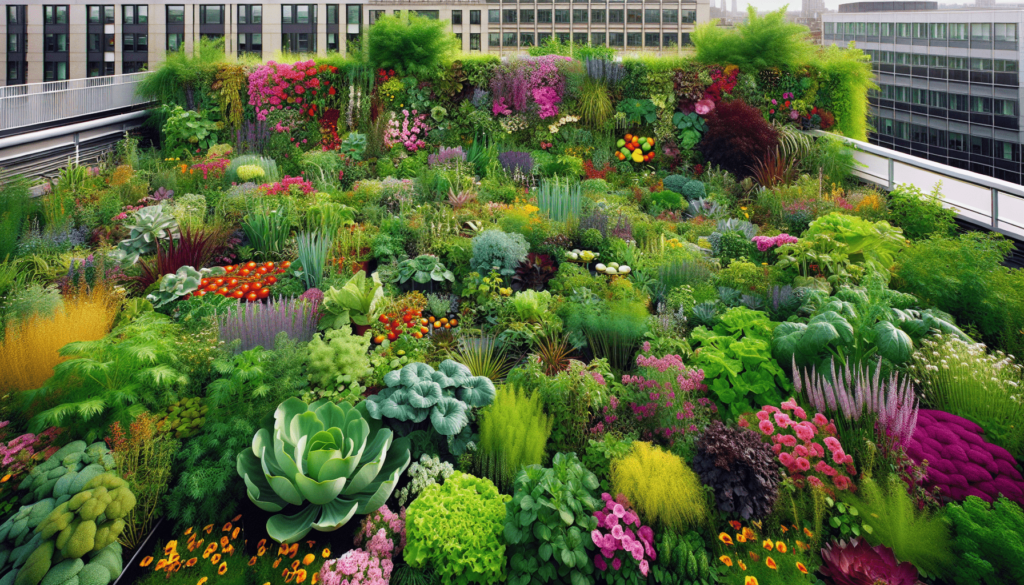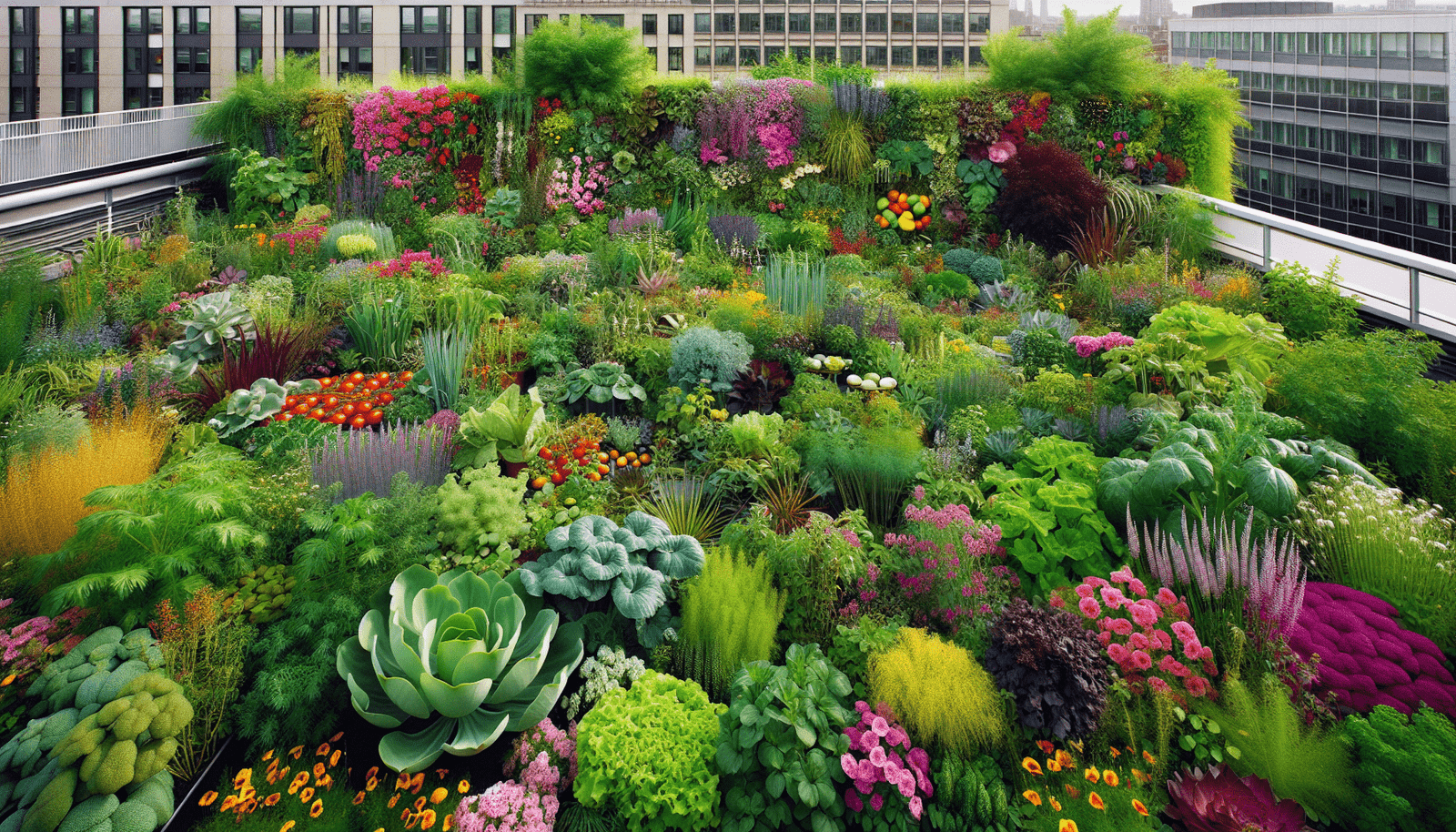Welcome to “The Ultimate Guide To Building A Green Roof Garden,” where you will learn everything you need to know about creating a beautiful and sustainable garden on your rooftop. From choosing the right plants to designing the layout and maintaining your green oasis, this article will provide you with the tips and tricks to turn your barren rooftop into a thriving green space. So grab your gardening tools and get ready to transform your roof into a mini paradise! Have you ever wondered how you can transform your boring roof into a vibrant, eco-friendly oasis? With a green roof garden, you can do just that! Not only will you be adding a touch of nature to your living space, but you’ll also be reducing your carbon footprint and helping to improve air quality. In this ultimate guide, we’ll walk you through all the steps you need to take to create your very own green roof garden. From planning and preparation to maintenance and care, we’ve got you covered. Let’s get started!
What is a Green Roof Garden?
A green roof garden, also known as a living roof or eco-roof, is a roof that is partially or completely covered with vegetation. These gardens provide numerous environmental benefits, such as reducing stormwater runoff, improving air quality, and reducing the urban heat island effect. In addition to their eco-friendly advantages, green roof gardens also offer aesthetic benefits, adding beauty and tranquility to urban settings.
Why Should You Consider Building a Green Roof Garden?
Building a green roof garden is not only a great way to enhance the visual appeal of your property, but it also offers a wide range of environmental and economic benefits. By installing a green roof garden, you can help to reduce energy costs by providing natural insulation, improve air quality by absorbing carbon dioxide and producing oxygen, and provide habitat for local wildlife. Additionally, green roof gardens can help to mitigate the urban heat island effect, reduce stormwater runoff, and increase the lifespan of your roof by protecting it from the elements.
Planning Your Green Roof Garden
Before you start building your green roof garden, it’s important to carefully plan out your project to ensure its success. Consider the following factors when planning your green roof garden:
Structural Integrity
Before installing a green roof garden, you’ll need to ensure that your roof is structurally sound and able to support the weight of the vegetation, soil, and any additional features you plan to include. Consult with a structural engineer to determine whether your roof can accommodate a green roof garden and make any necessary reinforcements.
Roof Slope and Drainage
The slope of your roof will play a crucial role in the success of your green roof garden. A roof with a gentle slope is ideal for drainage, while a flat roof may require additional structural features to prevent water pooling. Consider installing a drainage system, such as a green roof tray system, to ensure proper water runoff and prevent water damage.
Sun Exposure
The amount of sunlight your roof receives will determine the types of plants that can thrive in your green roof garden. Consider the orientation of your roof, as well as any shading from nearby structures or trees, to determine which plants will thrive in your specific conditions.
Local Climate
Consider the climate in your area when planning your green roof garden. Choose plants that are well-suited to your local climate and weather conditions to ensure they thrive in your green roof garden. Research the average temperatures, rainfall levels, and sunlight exposure in your area to select plants that are resilient and low-maintenance.

Designing Your Green Roof Garden
Once you’ve completed the planning phase, it’s time to design your green roof garden. Consider the following factors when designing your green roof garden:
Plant Selection
Choose plants that are well-suited to the conditions of your green roof garden, such as drought-tolerant succulents, grasses, and wildflowers. Consider the colors, textures, and heights of the plants you select to create a visually appealing and cohesive garden design. Research the growing requirements of each plant and select species that are low-maintenance and well-suited to the local climate.
Irrigation System
An efficient irrigation system is essential for maintaining a healthy green roof garden. Consider installing a drip irrigation system to ensure that your plants receive the right amount of water, without wasting resources. Monitor the moisture levels in your green roof garden regularly and adjust your irrigation schedule as needed to prevent overwatering or underwatering.
Access and Pathways
Consider how you will access your green roof garden and incorporate pathways or stepping stones to create a functional and inviting space. Add seating areas, lighting, and other amenities to enhance the usability of your green roof garden and create a welcoming outdoor retreat.
Eco-Friendly Features
Incorporate eco-friendly features into your green roof garden to enhance its sustainability. Consider installing a rainwater harvesting system to capture and store rainwater for irrigation, using recycled materials for hardscaping elements, and incorporating native plants to support local biodiversity.
Building Your Green Roof Garden
Once you’ve completed the planning and design phases, it’s time to start building your green roof garden. Follow these steps to create your own eco-friendly oasis:
Waterproofing
The first step in building a green roof garden is to ensure that your roof is properly waterproofed to prevent leaks and water damage. Install a waterproof membrane, such as a rubber or synthetic membrane, to create a barrier between the roof structure and the soil and vegetation.
Drainage Layer
Next, install a drainage layer on top of the waterproof membrane to facilitate water runoff and prevent water pooling on your green roof garden. Consider using a lightweight drainage material, such as expanded clay or recycled plastic, to create a free-draining substrate that will support healthy plant growth.
Growing Medium
After installing the drainage layer, add a layer of lightweight growing medium to provide nutrients and support for your plants. Select a growing medium that is specially formulated for green roof gardens, such as a lightweight soil mix or engineered growing medium, to ensure optimal plant growth and water retention.
Planting
Once you’ve prepared the substrate, it’s time to plant your green roof garden. Arrange your plants according to their growing requirements and spacing recommendations, taking care to group plants with similar moisture and sunlight needs together. Consider planting a mix of ground covers, perennials, and grasses to create a diverse and visually interesting garden.
Maintenance
After you’ve completed construction of your green roof garden, it’s important to establish a regular maintenance routine to keep your garden healthy and thriving. Monitor the moisture levels in your green roof garden, weed regularly, and prune any overgrown or damaged plants to maintain a tidy and attractive garden. Check for signs of pests or disease and address any issues promptly to prevent damage to your plants.

Benefits of a Green Roof Garden
There are numerous benefits to building a green roof garden, both for the environment and for your own well-being. Some of the key benefits of green roof gardens include:
- Environmental Benefits: Green roof gardens help to reduce stormwater runoff, mitigate the urban heat island effect, and improve air quality by absorbing carbon dioxide and producing oxygen.
- Energy Savings: Green roof gardens provide natural insulation, reducing heating and cooling costs and increasing the energy efficiency of buildings.
- Biodiversity: Green roof gardens create habitat for birds, bees, butterflies, and other wildlife, supporting local biodiversity and ecosystems.
- Aesthetics: Green roof gardens add beauty, tranquility, and visual interest to urban landscapes, creating a peaceful retreat for residents and visitors.
Maintaining Your Green Roof Garden
To ensure the long-term health and success of your green roof garden, it’s important to establish a regular maintenance routine. Consider the following tips for maintaining your green roof garden:
Watering
Monitor the moisture levels in your green roof garden regularly and adjust your irrigation schedule as needed to ensure that your plants receive the right amount of water. Water deeply and infrequently to encourage deep root growth and prevent water wastage.
Weeding
Regularly inspect your green roof garden for weeds and remove them promptly to prevent competition for nutrients and water. Mulch around your plants to suppress weed growth and retain soil moisture, reducing the need for frequent weeding.
Pruning
Prune any overgrown or damaged plants in your green roof garden to maintain a tidy and attractive appearance. Remove dead or diseased foliage, prune back overgrown branches, and shape your plants to encourage healthy growth and flowering.
Fertilizing
Add organic fertilizer to your green roof garden periodically to provide essential nutrients for plant growth. Consider using compost, compost tea, or organic fertilizers to improve soil fertility and promote healthy plant growth without harming the environment.
Pest Control
Monitor your green roof garden for signs of pests, such as aphids, mealybugs, or spider mites, and take action to prevent infestations. Consider using organic pest control methods, such as beneficial insects, insecticidal soaps, or neem oil, to reduce pest populations without harming beneficial insects.
Conclusion
Building a green roof garden is a rewarding and environmentally sustainable way to transform your living space into a vibrant, eco-friendly oasis. By carefully planning, designing, and constructing your green roof garden, you can enjoy the many benefits of green roof gardens, including reduced energy costs, improved air quality, and increased biodiversity. Follow the steps outlined in this ultimate guide to create your own green roof garden and reap the rewards of a beautiful, sustainable outdoor space. Happy gardening!

